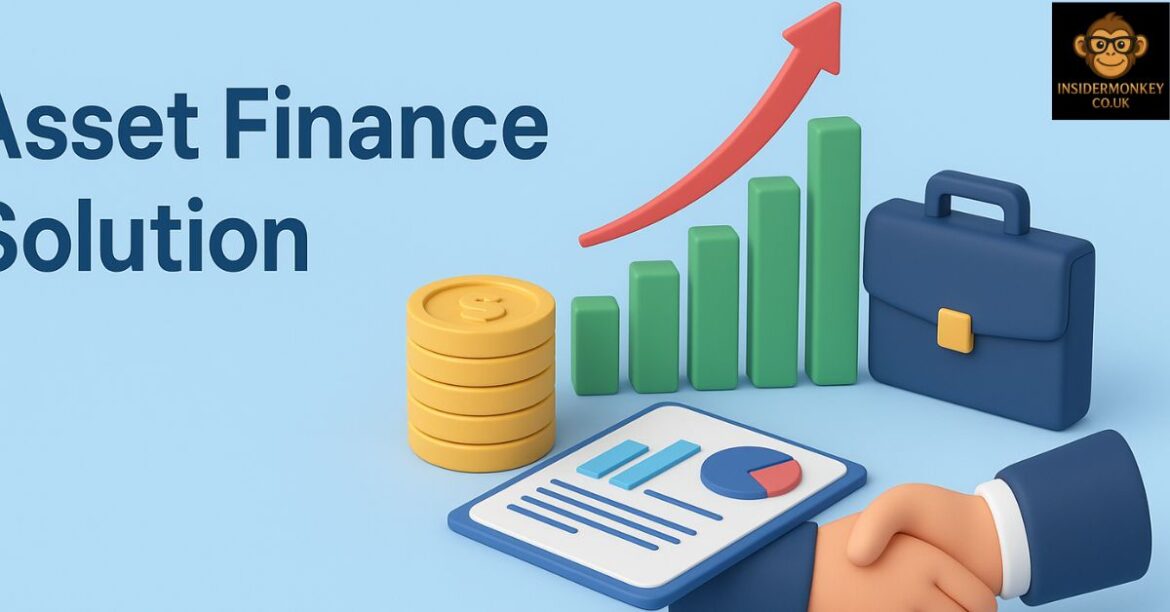Introduction
In today’s fast-moving business world, having access to the right assets — like machinery, vehicles, or IT equipment — can make all the difference. But buying everything upfront isn’t always possible, especially for startups or small businesses. That’s where asset finance solutions come in.
An asset finance solution allows you to use essential business equipment without paying the full amount immediately. Instead, you can spread the cost over time, keeping your cash flow healthy and your operations running smoothly.
What Is Asset Finance?
Asset finance is a flexible funding option that helps businesses acquire equipment, vehicles, or technology by paying in instalments rather than in one go.
Simply put, instead of buying an expensive machine outright, you lease or finance it through a lender. You then make monthly payments for a set period, after which you either own the asset or return it — depending on the agreement.
It’s like “renting to own,” but smarter and structured for business needs.
Types of Asset Finance Solutions
Here are the most common types of asset finance available in the UK and USA:
1. Hire Purchase
You pay for the asset over time through regular instalments. Once all payments are made, ownership is transferred to you. Ideal for businesses that want to eventually own the equipment.
2. Equipment Leasing
You lease equipment for a fixed period without owning it. It’s perfect for businesses that frequently upgrade machinery or technology.
3. Finance Lease
You rent the asset for most of its life, and at the end of the agreement, you can sell or extend the lease with a smaller payment.
4. Operating Lease
Similar to a rental. You only use the asset for a short period, and ownership remains with the finance company.
5. Refinance (Asset Refinance)
If you already own valuable assets, you can use them to release cash from your business by refinancing them.
Why Choose Asset Finance Solutions?
For many UK and US businesses, cash flow is king. Asset finance solutions help maintain liquidity while still enabling business growth.
Here’s why they’re worth considering:
Preserve Working Capital – Keep your cash free for daily operations or new opportunities.
Flexible Terms – Choose repayment plans that suit your business.
Tax Efficiency – Lease payments can often be tax-deductible.
Access to Latest Tech – Upgrade equipment without heavy upfront costs.
Fast Approval – Easier to access compared to traditional bank loans.
Industries That Benefit Most
Asset finance isn’t limited to one industry — it’s widely used across sectors:
-
Construction: For heavy machinery and vehicles
-
Transport & Logistics: For commercial fleets
-
IT & Tech: For servers, software, and equipment
-
Manufacturing: For production tools and systems
-
Healthcare: For diagnostic and medical devices
Any business that relies on costly equipment can gain from this financing approach.
Asset Finance vs Business Loan
| Feature | Asset Finance | Business Loan |
|---|---|---|
| Collateral | The asset itself | May require personal or business guarantee |
| Purpose | Specific asset purchase | Any business purpose |
| Ownership | At the end of term | Immediate ownership (but full payment upfront) |
| Flexibility | High (custom terms) | Depends on bank policy |
For businesses that want to grow without financial strain, asset finance offers a more strategic path.
How to Apply for an Asset Finance Solution
-
Assess Your Needs: Identify what assets you need and their cost.
-
Compare Lenders: Research finance providers in your region (UK/USA).
-
Check Terms: Understand interest rates, repayment duration, and ownership options.
-
Prepare Documents: You’ll need financial statements and company info.
-
Submit Application: Most lenders respond within days.
Once approved, the finance company pays for the asset, and you begin monthly instalments.
Best Practices for Using Asset Finance
-
Always compare interest rates before signing.
-
Avoid overcommitting — choose a plan within your budget.
-
Maintain your assets properly to avoid penalties.
-
Consult your accountant for tax optimization advice.
Asset Finance in the UK vs USA
In the UK, asset finance is supported by various regulated lenders like Close Brothers and Lombard.
In the USA, companies often go through providers like CIT, Wells Fargo, or small business loan platforms.
While both markets operate similarly, tax advantages and documentation may differ slightly. Always check local laws before applying.
Real-Life Example
Let’s say a small construction company in Manchester needs two new excavators worth £150,000.
Instead of paying the full amount, they opt for hire purchase asset finance — paying £3,000 per month over four years.
Result: They keep cash available for payroll, materials, and marketing, while still expanding their operations.
This flexibility is what makes asset finance one of the most practical business growth tools today.
Final Thoughts
Asset finance solutions have become a lifeline for modern businesses. Instead of draining your working capital, you can invest smartly in the assets that drive productivity and growth.
If you’re a small business in the UK or USA looking to expand without financial stress, asset finance might just be your smartest move in 2025.
Frequently Asked Questions (FAQs)
Q1. What is the minimum amount required for asset finance?
Usually, lenders start from as low as £5,000 or $10,000 depending on the asset type.
Q2. Does my business need a strong credit score?
A decent business credit score helps, but some lenders also look at asset value and revenue potential.
Q3. Can startups apply for asset finance?
Yes! Many finance companies now support startups if they show a solid business plan and growth potential.
Q4. Is asset finance only for vehicles and machinery?
No. It can cover IT systems, office equipment, medical devices, and even renewable energy setups.
Q5. Do I own the asset after the agreement ends?
It depends on the type of finance. In hire purchase, yes. In leasing, you can either return or renew.


